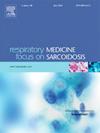Diaphragm function in patients with asthma and healthy controls: A cross-sectional study
IF 3.5
3区 医学
Q2 CARDIAC & CARDIOVASCULAR SYSTEMS
引用次数: 0
Abstract
Background
Asthma is a chronic respiratory disease characterized by airway inflammation and variable respiratory symptoms. While peripheral muscle deconditioning is known to affect lung function and exercise tolerance, the role of respiratory muscle dysfunction, particularly the diaphragm, remains underexplored.
Objective
We aim to evaluate potential differences in diaphragm function in patients with asthma.
Methods
We conducted a prospective, observational study comparing diaphragmatic function of 50 patients with asthma and 50 healthy controls. Two independent operators evaluated diaphragm contraction using tidal breathing thickening fraction (TF). Diaphragm dysfunction was defined as a TF < 20 %. Additional assessments included flow-volume spirometry, impulse oscillometry (IOS), FeNO, blood eosinophil count, and the Sniff Inspiratory Nasal Pressure (SNIP) test.
Results
Patients with asthma demonstrated significantly reduced diaphragm TF compared to healthy controls (p < 0.0001). Diaphragm dysfunction was significantly more prevalent in asthmatic patients (p < 0.0001), affecting 62%–66 % of the right hemidiaphragm and 46%–54 % of the left. Reduced TF was associated with longer disease duration (p = 0.03) and higher exacerbation rates (p = 0.04). No significant correlations were observed between TF and anthropometric data, asthma treatments, lung function, or Th2 biomarkers. SNIP measurements did not correlate with diaphragm TF. The limited sample size and the cross-sectional design were the main limitations of the study.
Conclusion
Diaphragm dysfunction is prevalent in asthma and associated with disease severity, including exacerbation frequency and longer disease duration. Impaired diaphragm function may contribute to persistent symptoms and exercise intolerance, representing a novel treatable trait in asthma management.
求助全文
约1分钟内获得全文
求助全文
来源期刊

Respiratory medicine
医学-呼吸系统
CiteScore
7.50
自引率
0.00%
发文量
199
审稿时长
38 days
期刊介绍:
Respiratory Medicine is an internationally-renowned journal devoted to the rapid publication of clinically-relevant respiratory medicine research. It combines cutting-edge original research with state-of-the-art reviews dealing with all aspects of respiratory diseases and therapeutic interventions. Topics include adult and paediatric medicine, epidemiology, immunology and cell biology, physiology, occupational disorders, and the role of allergens and pollutants.
Respiratory Medicine is increasingly the journal of choice for publication of phased trial work, commenting on effectiveness, dosage and methods of action.
 求助内容:
求助内容: 应助结果提醒方式:
应助结果提醒方式:


